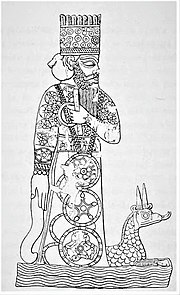Marduk
From Wikipedia, the free encyclopedia
Marduk (Sumerian spelling in Akkadian: AMAR.UTU 𒀫𒌓 "solar calf"; perhaps from MERI.DUG; Biblical Hebrew מְרֹדַךְ Merodach; Greek Μαρδοχαῖος[1], Mardochaios) was the Babylonian name of a late-generation god from ancient Mesopotamia and patron deity of the city of Babylon, who, when Babylon permanently became the political center of the Euphrates valley in the time of Hammurabi (18th century BC), started to slowly rise to the position of the head of the Babylonian pantheon, a position he fully acquired by the second half of the second millennium BC.
Nibiru, to the Babylonians, was the celestial body or region sometimes associated with the god Marduk.
Contents |
[edit] History

Marduk's original character is obscure but he was later on connected with water, vegetation, judgment, and magic.[2] He was also regarded as the son of Ea (Sumerian Enki) and Damkina and the heir of Anu, but whatever special traits Marduk may have had were overshadowed by the political development through which the Euphrates valley passed and which led to imbuing him with traits belonging to gods who at an earlier period were recognized as the heads of the pantheon. There are particularly two gods—Ea and Enlil—whose powers and attributes pass over to Marduk. In the case of Ea, the transfer proceeded pacifically and without effacing the older god. Marduk took over the identity of Asarluhi, the son of Ea and god of magic, so that Marduk was integrated in the pantheon of Eridu where both Ea and Asarluhi originally came from. Father Ea voluntarily recognized the superiority of the son and hands over to him the control of humanity. This association of Marduk and Ea, while indicating primarily the passing of the supremacy once enjoyed by Eridu to Babylon as a religious and political centre, may also reflect an early dependence of Babylon upon Eridu, not necessarily of a political character but, in view of the spread of culture in the Euphrates valley from the south to the north, the recognition of Eridu as the older centre on the part of the younger one.
While the relationship between Ea and Marduk is marked by harmony and an amicable abdication on the part of the father in favour of his son, Marduk's absorption of the power and prerogatives of Enlil of Nippur was at the expense of the latter's prestige. After the days of Hammurabi, the cult of Marduk eclipsed that of Enlil; although Nippur and the cult of Enlil enjoyed a period of renaissance during the four centuries of Kassite control in Babylonia (c. 1570 BC–1157 BC), the definite and permanent triumph of Marduk over Enlil became felt within the Babylonian empire. The only serious rival to Marduk after ca. 1000 BC was Aššur in Assyria. In the south, Marduk reigned supreme. He is normally referred to as Bel "Lord", also bel rabim "great lord", bêl bêlim "lord of lords", ab-kal ilâni bêl terêti "leader of the gods", aklu bêl terieti "the wise, lord of oracles", muballit mîte "reviver of the dead", etc.
When Babylon became the capital of Mesopotamia, the patron deity of Babylon was elevated to the level of supreme god. In order to explain how Marduk seized power, Enûma Elish was written, which tells the story of Marduk's birth, heroic deeds and becoming the ruler of the gods. This can be viewed as a form of Mesopotamian apologetics. Also included in this document are the fifty names of Marduk.
In Enûma Elish, a civil war between the gods was growing to a climactic battle. The Anunnaki gods gathered together to find one god who could defeat the gods rising against them. Marduk, a very young god, answered the call and was promised the position of head god.
When he killed his enemy, he "wrested from him the Tablets of Destiny, wrongfully his" and assumed his new position. Under his reign humans were created to bear the burdens of life so the gods could be at leisure.
Marduk was depicted as a human, often with his symbol the snake-dragon which he had taken over from the god Tishpak. Another symbol that stood for Marduk was the spade.
People were named after Marduk. For example, some scholars speculate that the Biblical character of Mordechai (Book of Esther) used this Persian name to replace his original Hebrew name, Bilshan.
Babylonian texts talk of the creation of Eridu by the god Marduk as the first city, "the holy city, the dwelling of their [the other gods] delight".
Nabu, god of wisdom, is a son of Marduk.
[edit] See also
[edit] References
- ^ identified with Marduk by Heinrich Zimmeren (1862-1931), Stade's Zeitschrift 11, p. 161.
- ^ [John L. McKenzie, Dictionary of the Bible, Simon & Schuster, 1965 p 541.]
- This article incorporates text from the Encyclopædia Britannica, Eleventh Edition, a publication now in the public domain.
[edit] External links
- The Mystica (article about Marduk)

